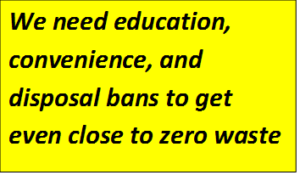Chickens are not something we would normally write about. And, in fact, this little story has less to do with dead chickens than with how they journey across Toronto in the after-life before landing between our knives and forks. Let me explain.
Until very recently in Toronto, fresh cut-up chickens were placed on foam trays with stretch wrap then placed in a corrugated box with their unfortunate comrades and trucked from the processor

or packer to a retailer’s distribution centre. From there they were trucked to various retail outlets across the Greater Toronto Area (GTA) for us to pick up and take home.
A truck can typically deliver about 12,000 knocked-down corrugated boxes to the chicken processor per trip. And the retailer ending up with the box receives revenue for sending that box on for recycling. Current revenues for old corrugated containers (OCC) are about $100 a tonne.
This circular loop system has been working very well, but now one major retailer has decided to change things up, forcing the chicken processors to do something different if they want to remain suppliers. We don’t have a problem with change but are very puzzled at the logic, extra costs, and increased environmental burden that this new move seems to entail, especially when that same retailer is telling the public that it is cutting carbon and improving the efficiency of moving goods.
The chicken processors in this example are now being forced to use what are called reusable plastic crates (RPCs) to deliver chicken. The costs of the box and the crate are roughly equal but because the crates take up more space on a truck you now need not one (corrugated) truck but four (plastic) trucks to deliver the same quantity of containers. More handling, more miles/kilometres, more burning of fossil fuels, more costs.
And in the crate scenario, someone must pay the (extra) cost of returning not one but four truckloads of crates to a distribution centre (which may be within or outside the GTA, or even out of province). Then that same person or someone else pays for trucking the collected crates to a wash centre, also possibly outside the GTA, out of province, or even in the US, so that the crates can be used again. More handling, more travel miles/kilometres, more burning of fossil fuels, more costs. And unlike in the corrugated box scenario, the retailer gets no revenue for returning the crates.
The chicken processors seem to be taking a major financial hit in this new arrangement. They now have not one truck in their yards delivering packaging but four, and those idling trucks must make it difficult to coordinate production flow at the plant (increasing their labour costs). They also now have the added expense of buying a polybag liner to protect the contents of each crate from leaking. Salmonella poisoning through pathogen transference is a major health risk when processing chickens and packing in crates that are to be used again.
What’s packaging got to do with the price of chicken? Maybe more than we think. Transportation and packaging are responsible for about 9% of the total greenhouse gas contributions of the poultry supply chain. If the crate transportation system outlined above costs more, and the environmental burden is greater, won’t those extra costs eventually be passed on to you and I as chicken-loving consumers?
The chicken processors will almost certainly be forced to pick up the tab, and will no doubt try to pass on their new costs to their customers (meaning us, eventually). But the biggest victim in this puzzling trial would seem to be the environment. Whichever way you slice it, it’s the planet that should be crying foul!

Very interesting and unsettling to think of new ways to add cost and prospective infectious situations to our food-chain. I can imagine the logistic issues this will certainly pose! Although one way cartons only get one usage, the carbon footprint (s) and the health implications for next life sanitation carry more cost and environmental repercussions. Along with a strain on the supply chain for extra deliveries and dock times…